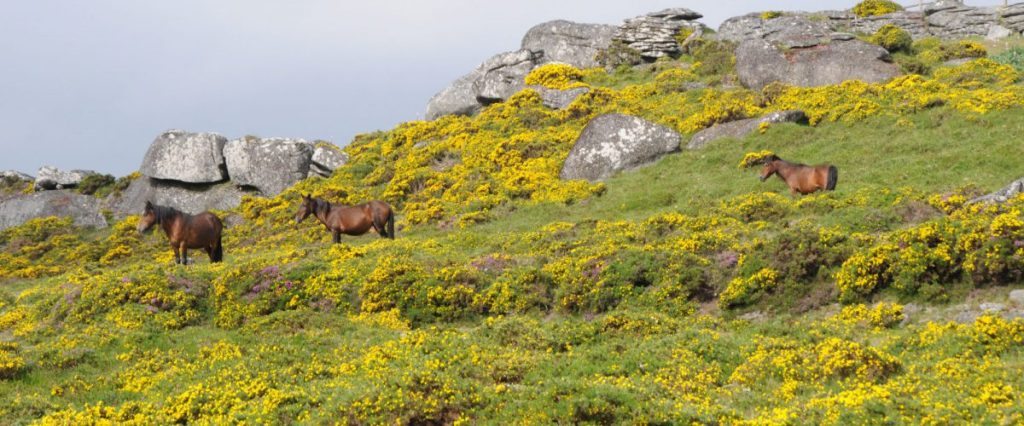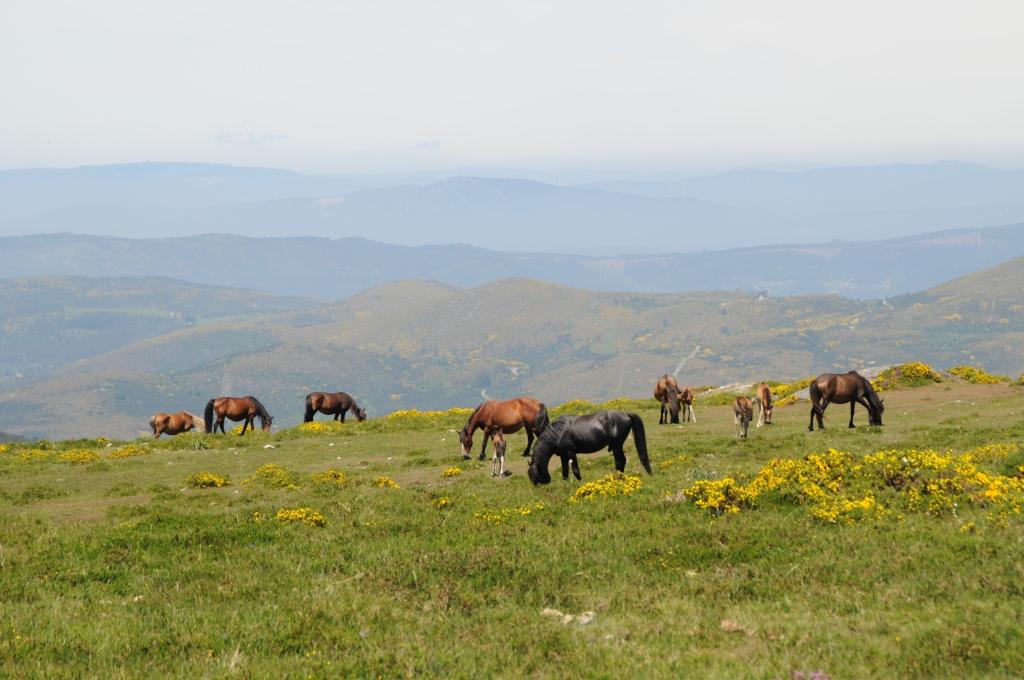This Wild Equus Atlas entry was provided by Dr. Laura Lagos, based on work and research carried out with the Galician wild ponies. Kudos!
Our atlas is a forever going-on project aimed at registering and mapping the free-living horse populations around the world. Please consider getting involved! You can register a population, share knowledge, or display your images!

Species: Equus caballus
Subspecies/Breed/Type: Galician wild ponies
Special note: Galician Ponies, which belong to the group of Atlantic Ponies or Garranos (Bárcena 2012). There is no evidence of this population of Garranos coming form domesticated populations, and it has even been proposed that the population of wild ponies living in the mountains of Galicia may constitute a subspecies of wild horse, Equus ferus atlanticus (Barcena, 2011). However this hypothesis needs DNA confirmation. Some individuals in the population having certain morphological characteristics have been registered as “Galician pure breed”.
Country: Spain
Region/Province/Range: Sierra de A Groba (A Groba Mountain Range), Pontevedra (Galicia)
Population type: Semi feral – slightly managed (Semi-feral according to a classification based on management, wild according to their probable origin.)
Estimated Population size: estimated 850-900 ponies
Management Practices
The traditional management of the Galician ponies includes the removal of the majority of the foals in annual round ups (curro). In the past yearlings were tamed and used for transport, haulage and work in the farms. Today foals are slaughtered for meat for consumption of the local people. In this round ups the manes and tails are shared. In the Sierra de A Groba the management is a bit more intensive, thus ponies are rounded up twice a year and, in these last years during captures ponies are also dewormed and treated for external parasites. In addition, adults are also equipped with micro-chips since it was established in a Galician Decree for domestic horses.
The traditional curros and this old harvesting system of the wild horse population has a great ethnographic value. Today they are still an important social event for locals and are becoming more and more a touristic attraction.
These ponies as a general fact inhabit communal land. It consist on communal forest, called Monte Vecinal en Mano Común (MVMC), belonging to a rural community formed by a group of people living usually in a parish, each parish has their communal forest. The people who traditionally harvest the ponies are called besteiros and they usually are not the owners of the land.
Ponies in these mountains are fire branded. The president of the association has a book with all the marks; some of them have been the same for generations. They are micro chipped since 1-2 years ago.

Details of Population
The Sierra de A Groba is a mountain range, situated in the southwest of Galicia, by the see in one of the most populated areas of Galicia (164 inhabitants per km2 in the surrounding municipalities). Altitudes are between 50-650 m above sea level. The landscapes consist on scrublands dominated by gorse (Ulex europaeus, Ulex minor) and heathers (Erica sp., Calluna vulgaris) together with forest of pines (Pinus pinaster, Pinus radiata) and eucalyptus (Eucalyptus globulus) cultivated for the wood and paper industry. Cattle, sheep, and goats in some areas, are raised in these mountains. Wolves, which are the natural predators of the Galician wild ponies, were extirpated from these mountains in the seventies. The ponies live in an area of about 12,000 ha.
The characteristics of the Galician ponies are reduced size, frequently bay or black coat, curved back, big abdomen and a dense “moustache” which presumably is an adaptation to the consumption of the prickly gorse. The Galician ponies in the Sierra de A Groba are the smallest in Galicia: the average height on shoulders for mares is 119 cm. The moustache is present in about 47% of the mares. In Sierra de A Groba the ponies are called “burras”.
Structure and demographics
Removal of foals means that the sex ratio of adults is artificial and it is maintained at 40-50 mares per stallion. There are 18-20 stallions in the population. Studies on wild ponies in other mountains of Galicia indicate that foaling rate is 0,67 (Lagos 2013), however, in these mountains the habitat is rougher, consequently, the foaling rates are presumably lower.
The census is decreasing. Thirty years ago the population size was 2,000-2,500 ponies (Iglesia 1973) and only 8-10 years ago 1,500 ponies lived in these mountains. The decrease is due to the disappearance of their traditional uses of the ponies, and since 2008 due to the implementation of the regulations for micro chipping of the ponies and other measures which burden this traditional system.
Issues worth noting and needed actions
The implementation of the regulations for micro chipping of the ponies and other measures which burden this traditional system are causing a reduction of the population of ponies and many besteiros giving up this tradition that their families have continued for generations. It is necessary to have regulations adapted to the characteristics of this population of wild ponies. At least, the exceptions contemplated by the European regulations (EC No 504/2008) for the equidae constituting defined populations living under wild or semi-wild conditions should be applied.
There is an insufficient knowledge of the biological, ecological and cultural value of this population by the managers of the land and the government. It is necessary to disseminate the importance of this population to the public, to the managers of the land and to the government.
Research is needed in order to learn what is the true importance of Galician wild ponies as key species in the habitat, as well as to improve knowledge about their genetics and ecology.
The management of this populations should be more adapted to the biology of these animals.

Bibliography and Further reading
BÁRCENA, F. 2012. Garranos: Os póneis selvagens (Equus ferus sp.) do norte da Península Ibérica. Pages 75-96 en N. Vieira de Brito y G. Candeiras (coord.), Libro de Actas del I Congresso Internacional do Garrano. Arcos de Valdevez. Portugal.
IGLESIA, P. 1973. Los Caballos Gallegos Explotados en Régimen de Libertad o Ca¬ballos Salvajes de Galicia. Tesis, Facultad de Veterinaria, Universidad Complutense de Madrid, Madrid, 1.205 p
LAGOS, L. 2013. Ecología del lobo (Canis lupus), del poni salvaje (Equus ferus atlanticus) y del ganado vacuno semiextensivo (Bos taurus) en Galicia: interacciones depredador-presa. Tesis, Universidad de Santiago de Compostela, Santiago de Compostela, 458 pp.
LAGOS, L. 2014. O sistema tradicional de aproveitamento dos ponis atlánticos salvaxes nos montes da Groba, Morgadáns e Galiñeiro. Retos no século XXI. Revista del Instituto de Estudios Miñoranos 12/13
If you have further information or images you would like to share please contact us by email.
More entries to the Wild Equus Atlas;
Venezuelan Creoles WE – Entry from Dr. Jose Luis Canelon
Pottoka Piornal ponies WE – Entry from Lucy Ress
Pryor Mountain wild horses WE – Entry from Dr. Jason Ransom
McCullough Peaks horses – Entry from Dr. Jason Ransom
Aveto horses (WE) – Entry from Evelina Isola
Galician wild ponies WE – Entry from Dr. Laura Lagos
Namibia Desert horses WE – Entry from Dr. Telané Greyling
Delft Island horses WE – Entry from Wild Equus
Little Book Cliffs Wild Horses WE – Entry from Dr. Jason Ransom
Gower ponies WE – Entry from Jennie Nellist
Baguales WE – Entry from Dr. Victor Moraga and Enrique Zunzunegui
Exmoor Ponies WE – Entry from Sue McGeever
Tornquist feral horses WE – Entry from Dr. Alberto Scorolli
Sabucedo horses WE – Entry from Ivan Sanmartin Eirin
Cumberland Island horses WE – Entry from Wild Equus
Feral horses of Cotopaxi WE – Entry from Javier Solis Méndez, Lucy Rees, Johanna Marlès and Juan Bermeo
This is an ongoing work, and as such, will be updated regularly as new information is made available. Please share this initiative far and wide. Gracias!


